MS Estonia
MS Estonia was a cruise ferry built in 1979/80 at the German shipyard Meyer Werft in Papenburg. The ship sank in 1994 in the Baltic Sea in one of the worst maritime disasters of the 20th century.[2][3] It is the second-deadliest peacetime sinking of a European ship, after the RMS Titanic, and the deadliest peacetime shipwreck to have occurred in European waters, with 852 lives lost.[4]
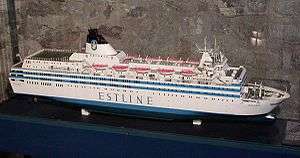 Scale model of MS Estonia | |
| History | |
|---|---|
| Name: |
|
| Owner: |
|
| Operator: |
|
| Port of registry: | |
| Ordered: | 1979-09-11 |
| Builder: | Meyer Werft, Papenburg, West Germany |
| Yard number: | 590 |
| Laid down: | 18 October 1979 |
| Launched: | 26 April 1980 |
| Acquired: | 29 June 1980 |
| In service: | 5 July 1980 |
| Identification: |
|
| Fate: | Capsized and sank on 28 September 1994 |
| General characteristics | |
| Type: | Ro Ro Passenger Cruise |
| Tonnage: | |
| Length: |
|
| Beam: | 24.21 m (79 ft 5 in) |
| Draught: | 5.60 m (18 ft 4 in) |
| Decks: | 9 |
| Ice class: | 1A |
| Installed power: |
|
| Speed: | 21.1 knots (39.1 km/h; 24.3 mph) |
| Capacity: |
|
Construction
The ship was originally ordered from Meyer Werft by a Norwegian shipping company led by Parley Augustsen with intended traffic between Norway and Germany. At the last moment, the company withdrew their order and the contract went to Rederi Ab Sally, one of the partners in the Viking Line consortium (SF Line, another partner in Viking Line, had also been interested in the ship).[5]
Originally the ship was conceived as a sister ship to Diana II, built in 1979 by the same shipyard for Rederi AB Slite, the third partner in Viking Line. When Sally took over the construction contract, the ship was lengthened from the original length of approximately 137 metres (449 ft) to approximately 155 metres (509 ft) and the superstructure of the ship was largely redesigned.[5]
Meyer Werft had constructed a large number of ships for various Viking Line partner companies during the 1970s. The construction of the ship's bow consisted of an upwards-opening visor and a car ramp that was placed inside the visor when it was closed. An identical bow construction had also been used in Diana II.[JAIC 1]
Service history
Estonia previously sailed as Viking Sally (1980–1990), Silja Star (1990–1991), and Wasa King (1991–1993).
Viking Line
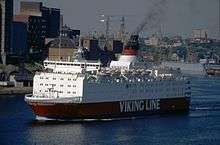
On 29 June 1980 Viking Sally was delivered to Rederi Ab Sally, Finland and was put into service on the route between Turku, Mariehamn and Stockholm[5][6] (during summer 1982 on the Naantali–Mariehamn–Kapellskär route).[7] She was the largest ship to serve on that route at the time. As with many ships, Viking Sally suffered some mishaps during her Viking Line service, being grounded in the Åland Archipelago in May 1984 and suffering some propeller problems in April of the following year. In 1985 she was also rebuilt with a "duck tail".[5][6] Rederi Ab Sally had been experiencing financial difficulties for most of the 1980s. In late 1987, Effoa and Johnson Line, the owners of Viking Line's main rivals Silja Line, bought Sally.[8] As a result of this, SF Line and Rederi AB Slite forced Sally to withdraw from Viking Line.[5][6][8] Viking Sally was chartered to Rederi AB Slite to continue on her current traffic for the next three years.[5][6][8]
EffJohn
When her charter ended in April 1990, Viking Sally had an unusual change of service. She was painted in Silja Line's colours, renamed Silja Star and placed on the same route that she had plied for Viking Line: Turku–Mariehamn–Stockholm.[5][6] The reason for this was that Silja's new ship for Helsinki–Stockholm service was built behind schedule and one of the Turku–Stockholm ships, Wellamo, was transferred to that route until the new ship was complete in November 1990.[9] Also in 1990 Effoa, Johnson Line and Rederi Ab Sally merged into EffJohn.
The following spring Silja Star began her service with Wasa Line, another company owned by EffJohn. Her name was changed to Wasa King and she served on routes connecting Vaasa, Finland to Umeå and Sundsvall in Sweden.[5][6] It has been reported that the Wasa King was widely considered to be the best behaving ship in rough weather to have sailed from Vaasa.
Estline
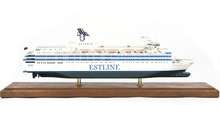
In January 1993, at the same time when EffJohn decided to merge Wasa Line's operations into Silja Line, Wasa King was sold to Nordström & Thulin for use on EstLine's Tallinn–Stockholm traffic under the name Estonia. The actual ownership of the ship was rather complex, in order for Nordstöm & Thulin to get a loan to buy the ship. Although Nordström & Thulin were the company who bought the ship, her registered owners were Estline Marine Co Ltd, Nicosia, Cyprus, who chartered the ship to E.Liini A/S, Tallinn, Estonia (daughter company of Nordström & Thulin and ESCO) who in turn chartered the ship to EstLine Ab. As a result, the ship was actually registered in both Cyprus and Estonia.[5][6]
As the largest Estonian-owned ship of the time, the Estonia symbolized the independence that Estonia regained after the collapse of the Soviet Union.[10]
Sinking
| Nationality of the victims[11] | Deaths |
|---|---|
| 501 | |
| 285 | |
| 17 | |
| 11 | |
| 10 | |
| 6 | |
| 5 | |
| 5 | |
| 3 | |
| 2 | |
| 1 | |
| 1 | |
| 1 | |
| 1 | |
| 1 | |
| 1 | |
| 1 | |
| Total fatalities | 852 |
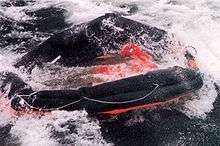
The Estonia disaster occurred on Wednesday, 28 September 1994, between about 00:55 and 01:50 (UTC+2) as the ship was crossing the Baltic Sea, en route from Tallinn, Estonia, to Stockholm, Sweden. Estonia was on a scheduled crossing with departure at 18:30 on 27 September. She had been expected in Stockholm the next morning at about 09:30. She was carrying 989 people: 803 passengers and 186 crew.[12][JAIC 2] Most of the passengers were Swedish, although some were of Estonian origin, while most of the crew members were Estonian. The ship was fully loaded, and was listing slightly to starboard because of poor cargo distribution.[13]
According to the final disaster report, the weather was rough, with a wind of 15 to 20 metres per second (29 to 39 kn; 34 to 45 mph), force 7–8 on the Beaufort scale and a significant wave height of 4 to 6 metres (13 to 20 ft)[JAIC 3] compared with the highest measured significant wave height in the Baltic Sea of 7.7 metres (25.3 ft).[14] Esa Mäkelä, the captain of Silja Europa who was appointed on-scene commander for the subsequent rescue effort, described the weather as "normally bad", or like a typical autumn storm in the Baltic Sea. All scheduled passenger ferries were at sea. The official report says that while the exact speed at the time of the accident is not known, Estonia had very regular voyage times, averaging 16 to 17 knots (30 to 31 km/h; 18 to 20 mph). The chief mate of the Viking Line cruiseferry Mariella tracked Estonia's speed by radar at approximately 14.2 knots (26.3 km/h; 16.3 mph) before the first signs of distress, while the Silja Europa's officers estimated her speed at 14 to 15 knots (26 to 28 km/h; 16 to 17 mph) at midnight.
The first sign of trouble aboard Estonia was when a metallic bang was heard, caused by a heavy wave hitting the bow doors around 01:00, when the ship was on the outskirts of the Turku archipelago, but an inspection—limited to checking the indicator lights for the ramp and visor—showed no problems.[13] Over the next 10 minutes, similar noises were reported by passengers and other crew.[13] At about 01:15, the visor separated and the ship's bow door opened. The ship immediately took on a heavy starboard list (initially around 15 degrees, but by 01:30, the ship had rolled 60 degrees and by 1:50 the list was 90 degrees) as water flooded into the vehicle deck.[13] Estonia was turned to port and slowed before her four engines cut out completely.[13]
At about 01:20, a quiet female voice called "Häire, häire, laeval on häire", Estonian for "Alarm, alarm, there is alarm on the ship", over the public address system, which was followed immediately by an internal alarm for the crew, then one minute later by the general lifeboat alarm. The vessel's rapid list and the flooding prevented many people in the cabins from ascending to the boat deck, as water not only flooded the vessel via the car deck, but also through windows in cabins as well as the massive windows along deck 6. The windows gave way to the powerful waves as the ship listed and the sea reached the upper decks. Survivors reported that water flowed down from ceiling panels, stairwells and along corridors from decks that were not yet under water. This contributed to the rapid sinking.[13] A Mayday was communicated by the ship's crew at 01:22, but did not follow international formats. Estonia directed a call to Silja Europa and only after making contact with her did the radio operator utter the word "Mayday". The radio operator on Silja Europa, chief mate Teijo Seppelin, replied in English: "Estonia, are you calling mayday?" After that, the voice of third mate Andres Tammes took over on Estonia and the conversation shifted to Finnish.[15] Tammes was able to provide some details about their situation but, due to a loss of power, he could not give their position, which delayed rescue operations somewhat. Some minutes later, power returned (or somebody on the bridge managed to lower himself to the starboard side of the bridge to check the marine GPS, which will display the ship's position even in blackout conditions), and the Estonia was able to radio its position to Silja Europa and Mariella. The ship disappeared from the radar screens of other ships at around 01:50,[13] and sank at 59°23′N 21°42′E in international waters, about 22 nautical miles (41 km; 25 mi) on bearing 157° from Utö island, Finland, to the depth of 74 to 85 metres (243 to 279 ft) of water. According to survivor accounts, the ship sank stern first after taking a list of 90 degrees.
Rescue effort
Search and rescue followed arrangements set up under the 1979 International Convention on Maritime Search and Rescue (the SAR Convention), and the nearest Maritime Rescue Co-ordination Centre MRCC Turku coordinated the effort in accordance with Finland's plans. The Baltic is one of the world's busiest shipping areas, with 2,000 vessels at sea at any time, and these plans assumed the ship's own boats and nearby ferries would provide immediate help and that helicopters could be airborne after an hour. This scheme had worked for the relatively small number of accidents involving sinkings, particularly as most ships have few people on board.[16]
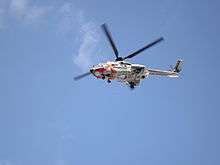
Mariella, the first of five ferries to reach the scene of the accident, arrived at 02:12.[2] MRCC Turku failed to acknowledge the Mayday immediately and Mariella's report was relayed by Helsinki Radio as the less urgent pan-pan message. A full-scale emergency was only declared at 02:30. Mariella winched open liferafts into the sea onto which 13 people on Estonia's rafts successfully transferred, and reported the location of other rafts to Swedish and Finnish rescue helicopters, the first of which arrived at 03:05. The former took survivors to shore, while the latter—Finnish border guard helicopters Super Puma OH-HVG and Agusta Bell 412 OH-HVD—chose the riskier option of landing on the ferries. The pilot of OH-HVG stated that landing on the ferries was the most difficult part of the whole rescue operation; despite that, this single helicopter rescued 44 people, more than all the ferries. Isabella saved 16 survivors with her rescue slide.
Of the 989 on board, 138 were rescued alive, one of whom died later in hospital.[2] Ships rescued 34 and helicopters 104; the ferries played a much smaller part than the planners had intended because it was too dangerous to launch their man-overboard (MOB) boats or lifeboats. The accident claimed 852 lives. Most died by drowning and hypothermia, as the water temperature was 10–11 °C/50–52 °F. One of the victims of the sinking was the Estonian singer Urmas Alender. In total, 94 bodies were recovered: 93 within 33 days of the accident, the last victim was found 18 months later.[2] By the time the rescue helicopters arrived, around a third of those who escaped from the Estonia had died of hypothermia, while fewer than half of those who had managed to leave the ship were eventually rescued.[2] The survivors of the shipwreck were mostly young males generally of strong constitution. Seven over 55 years of age survived and there were no survivors under age 12. About 650 people were still inside the ship when it sank. [JAIC 2] The commission estimated that up to 310 passengers reached the outer decks, 160 of whom boarded the life-rafts or lifeboats. [17]
Causes of the disaster
The disaster had a major impact on ferry safety, leading to changes in safety regulations as well as in life-raft design,[18] much as the Titanic disaster did in 1912.
Official investigation and report
The wreck was examined and videotaped by remotely operated underwater vehicles and by divers from a Norwegian company, Rockwater A/S, contracted for the investigation work.[JAIC 4] The official report indicated that the locks on the bow door had failed from the strain of the waves and the door had separated from the rest of the vessel, pulling the ramp behind it ajar.[JAIC 5] The bow visor and ramp had been torn off at points that would not trigger an "open" or "unlatched" warning on the bridge, as is the case in normal operation or failure of the latches. The bridge was also situated too far back on the ferry for the visor to be seen from there.[JAIC 6] While there was video monitoring of the inner ramp, the monitor on the bridge was not visible from the conning station.[JAIC 7] The bow visor was under-designed, as manufacturing and approval process did not consider the visor and its attachments as critical items regarding ship safety.[19] The first metallic bang was believed to have been the sound of the visor's lower locking mechanism failing, and subsequent noises were the visor 'flapping' against the hull as the other locks failed, before tearing free and exposing the bow ramp.[20] The subsequent failure of the bow ramp allowed water into the vehicle deck, which was identified as the main cause of the capsizing and sinking:[19] RORO ferries with their wide vehicle decks are particularly vulnerable to capsizing if the car deck is even slightly flooded because of free surface effect: the fluid's swirling motion across such a large area hampers the boat's ability to right itself after rolling with a wave. The same effect caused the capsizing of MS Herald of Free Enterprise seven years earlier.
The report was critical of the crew's actions, particularly for failing to reduce speed before investigating the noises emanating from the bow, and for being unaware that the list was being caused by water entering the vehicle deck.[21] There were also general criticisms of the delays in sounding the alarm, the passivity of the crew, and the lack of guidance from the bridge.
Recommendations for modifications to be applied to similar ships included separation of the condition sensors from the latch and hinge mechanisms.[JAIC 8]
Changes stemming from the disaster
In 1999, special training requirements in crowd and crisis management and human behaviour were extended to crew on all passenger ships, and amendments were made to watch-keeping standards.[22]
Estonia's distress beacons or EPIRBs required manual activation, which did not happen. Had they been activated automatically, it would have been immediately obvious that the ship had sunk and the location would have been clear. All EPIRBs were subsequently required to deploy automatically and the accident was "instrumental in the move to legislate Voyage Data Recorders".[23] New International Maritime Organization (IMO) Safety of Life at Sea (SOLAS) liferaft regulations for rescue from listing ships in rough water were introduced, though launching such craft, even in training exercises, remains dangerous for the crew.[24]
New designs, the "citadel concept" once again influenced by Estonia, aim to ensure damaged ships have sufficient buoyancy to remain afloat, though cost will determine if any are built. SOLAS 90, which came into effect in 2010, specifies existing passenger ships' stability requirements and those in North West Europe must also be able to survive 50 centimetres (20 in) of water on the car deck.[25]
Allegations of military connection
Alternative theories exist about the cause of the sinking. German journalist Jutta Rabe and the left-wing magazine New Statesman claim that laboratory tests on debris recovered illegally from Estonia's bow yielded trace evidence of a deliberate explosion, which they allege was concealed by the Swedish, British, and Russian governments to cover up an intelligence operation smuggling military hardware via the civilian ferry.[26] Members of the Joint Accident Investigation Commission denied these claims, saying that the damage seen on the debris occurred during the visor's detachment from the vessel. The JAIC cited results from Germany's Federal Institute for Materials Research and Testing, which found that Jutta Rabe's samples did not prove an explosion occurred.[27]
In the autumn of 2004, a former Swedish customs officer claimed on Sveriges Television that Estonia had been used to transport military equipment in September 1994.[28] The Swedish and Estonian governments subsequently launched separate investigations, which both confirmed that non-explosive military equipment was aboard the ship on 14 and 20 September 1994. According to the Swedish Ministry of Defence, no such equipment was on board on the day of the disaster, and previous investigations by the Swedish Customs Service found no reports of any anomalous activity around the day of the disaster.[29][30]
Protection of the wreck
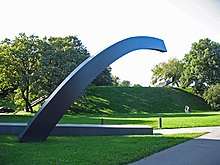
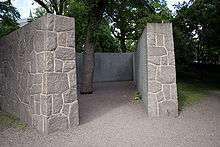
In the aftermath of the disaster, many relatives of the deceased demanded that their loved ones be raised from international waters and given a land burial. Demands were also made that the entire ship be raised so that the cause of the disaster could be discovered by detailed inspection.[31][32] Citing the practical difficulties and the moral implications of raising decaying bodies from the sea floor (the majority of the bodies were never recovered), and fearing the financial burden of lifting the entire hull to the surface and the salvage operation, the Swedish government suggested burying the whole ship in situ with a shell of concrete.[33][34] As a preliminary step, thousands of tons of pebbles were dropped on the site.[32] The Estonia Agreement 1995, a treaty among Sweden, Finland, Estonia, Latvia, Poland, Denmark, Russia and the United Kingdom, declared sanctity over the site, prohibiting their citizens from even approaching the wreck.[35] The treaty is, however, only binding for citizens of the countries that are signatories. At least twice, the Swedish Navy has discovered diving operations at the wreck. The wreck is monitored by radar by the Finnish Navy.[36]
Decks and facilities
As Viking Sally
| 9 | Bridge, sundeck[37] |
| 8 | Sundeck[37] |
| 7 | Crew cabins & facilities, sundeck[38] |
| 6 | Restaurant deck – Buffet dining room, à la carte restaurant, bar, outside and inside cabins[39] |
| 5 | Entrance & cafeteria deck – Tax-free shops, cafeteria, snack bar, discotheque, air seats, children's playroom, outside and inside cabins[37][40] |
| 4 | Conference deck – Conference rooms, nightclub, cinema, inside and outside cabins[40] |
| 3 | Car platform[41] |
| 2 | Car deck[41] |
| 1 | Inside cabins,[39] engine room[38] |
| 0 | Sauna, swimming pool, conference rooms[39] |
Media
The sinking of the Estonia has been the subject of a number of documentaries in addition to the feature film Baltic Storm, including:
- History Channel: Sinking of the Estonia
- Zero Hour: The Sinking of the Estonia (2006)
- Built from Disaster: Ships (2009)[42]
It was also mentioned in the Swedish film, Force Majeure.
In addition, the disaster has inspired several musical works:
- Canticum Calamitatis Maritimae, a choral work by Jaakko Mäntyjärvi
- Incantatio maris aestuosi, a choral work by Veljo Tormis
- "Estonia", a song by Marillion
- "Ever so blue", a song by Heini Vaikmaa and performed by Rodrigo Fomins
- "Vedenalainen maailma", a song by Laura Sippola
- "Estonia hukk", a lament by Virve Köster
- Lamento, for organ ("Lament over the Estonia Catastrophe") by Erland von Koch
See also
- List of RORO vessel accidents
- List of accidents and disasters by death toll
- List of shipwrecks in 1994
References
- Final report on the capsizing on 28 September 1994 in the Baltic Sea of the Ro-Ro passenger vessel MN Estonia, Chapter 3: The vessel. The Joint Accident Investigation Commission of Estonia, Finland and Sweden, December 1997.
- Soomer, H.; Ranta, H.; Penttilä, A. (2001). "Identification of victims from the M/S Estonia". International Journal of Legal Medicine. 114 (4–5): 259–262. doi:10.1007/s004140000180. PMID 11355406.
- Boesten, E. (2006): The M/S Estonia Disaster and the Treatment of Human Remains. In: Bierens, J.J.L.M. (ed.): Handbook on Drowning: 650–652. ISBN 978-3-540-43973-8.
- "Estonia shipwreck investigator and nautical linguist Captain Uno Laur dies". ERR. Retrieved 23 March 2019.
- "Wasa King" (in Swedish). Vasabåtarna.se. Retrieved 29 October 2007.
- "M/S Viking Sally" (in Swedish). Fakta om Fartyg. Retrieved 29 October 2007.
- "Viking Sally schedules 1980–1990" (in Finnish). FCBS Forum. Retrieved 29 October 2007.
- "Simplon Postcards: Viking Sally – Wasa King – Silja Star – Estonia". Retrieved 28 September 2014.
- "MS Wellamo (1986)" (in Swedish). Fakta om Fartyg. Retrieved 29 October 2007.
- "The Sinking of the Estonia." Surviving Disaster. BBC.
- "Final report on the MV ESTONIA disaster of 28 September 1994". onse.fi. Retrieved 28 September 2017.
- Whittingham, The Blame Machine, p. 137
- Whittingham, The Blame Machine, p. 138
- "Wave height records in the Baltic Sea". Finnish Meteorological Institute. Archived from the original on 30 September 2009.
- "Estonia final report. 2.1 The Distress Communication". estoniaferrydisaster.net. Archived from the original on 4 March 2016. Retrieved 24 June 2018.
- HELCOM reports a noticeable drop in shipping accidents in the Baltic Archived 27 December 2007 at the Wayback Machine. Retrieved 21 October 2007
- "Improving passenger ship safety" (PDF). Directorate-General for Transport and Energy (European Commission). Archived from the original (PDF) on 28 February 2008. Retrieved 30 September 2007.
- Joughin, R.W. "The Revised SOLAS Regulations for Ro-Ro Ferries". Warsah Maritime Centre. Archived from the original on 3 April 2008. Retrieved 3 April 2008.
- Whittingham, The Blame Machine, p. 139
- Whittingham, The Blame Machine, pp. 139–40
- Whittingham, The Blame Machine, p. 142
- "Passenger information required on all passenger ships from 1 January 1999". International Maritime Organization. Archived from the original on 12 November 2007. Retrieved 21 October 2007.
- Simplified Voyage Data Recorders -Why choose float free Archived 12 November 2007 at the Wayback Machine. Retrieved 22 October 2007
- Liferaft Systems Australia: Maib Interim Safety Recommendation on The Use of Vertical Chute Type Marine Evacuation Systems Archived 29 August 2007 at the Wayback Machine. Retrieved 21 October 2007
- Sturcke, James (6 March 2007). "Herald of sea changes". The Guardian. Retrieved 30 November 2007.
- Davis, Stephen (23 May 2005). "Death in the Baltic: the MI6 connection". New Statesman. Archived from the original on 12 July 2005. Retrieved 19 August 2013.
- Tukkimäki, Paavo (20 February 2001). "Finnish Estonia Commission members still reject explosion theories". Helsingin Sanomat. Archived from the original on 12 May 2011.
- Borgnäs, Lars (Fall 2004). "War materials smuggled on Estonia". Uppdrag granskning. Sveriges Television. Archived from the original on 13 June 2011. Retrieved 29 September 2009.
- "Utredningen om transport av försvarsmateriel på M/S Estonia" (in Swedish). Ministry of Defence (Sweden). 21 January 2005.
- "Riigikogu Committee of Investigation to Ascertain the Circumstances Related to the Export of Military Equipment from the Territory of the Republic of Estonia on the Ferry Estonia in 1994 – Final Report". Riigikogu. 19 December 2006. Archived from the original on 22 July 2011.
- Wallius, Anniina (29 September 2004). "Estonian tuho lietsoi salaliittoteorioita" (in Finnish). YLE. Archived from the original on 12 May 2011.
- Whittingham, The Blame Machine, p. 140
- "Justitieutskottets betänkande 1994/95: JuU23 Gravfrid över m/s Estonia" (in Swedish). The Riksdag. 18 May 1995.
- "Chapter 50: Övertäckningen stoppas". En granskning av Estoniakatastrofen och dess följder. Statens offentliga utredningar (in Swedish). SOU 1998:132. Statens offentliga utredningar.
- "Agreement between the Republic of Estonia, the Republic of Finland and the Kingdom of Sweden regarding the M/S Estonia". Ministry for Foreign Affairs (Sweden). 23 February 1995.
- Danné, Ulla; Nilsson, Birgitta /TT (18 May 1998). "Sjöfartsverket höll tyst om stoppade Estonia-dykare". Aftonbladet (in Swedish).
- "Viking Sally deck plan". Viking Line brochure (in Finnish, Swedish, and English). Vasabåtarna.se. Retrieved 20 December 2008.
- "Viking Sally General Arrangement plan". Vasabåtarna.se. Retrieved 20 December 2008.
- "Viking Sally Restaurant deck 6 plan". Viking Line brochure (in Swedish and Finnish). Vasabåtarna.se. Retrieved 20 December 2008.
- "Viking Sally Conference deck 4 plan". Viking Line brochure (in Swedish and Finnish). Vasabåtarna.se. Retrieved 20 December 2008.
- "Viking Sally cutaway". Viking Line brochure (in Swedish, Finnish, and English). Vasabåtarna.se. Retrieved 20 December 2008.
- "Built From Disaster Season 1 Episode 2: Ships". TV Guide. Retrieved 29 September 2017.
General
- Whittingham, Robert B. (2004). "Design errors". The Blame Machine: why human error causes accidents. Oxford: Elsevier Butterworth-Heinemann. ISBN 0-7506-5510-0.
- "Final report on the MV ESTONIA disaster of 28 September 1994". Helsinki: Joint Accident Investigation Commission. 1997. Archived from the original on 2 June 2001. Cite journal requires
|journal=(help)CS1 maint: unfit url (link)
- Chapter 11.3 – The DIANA II incident
- Chapter 7.6 – The human outcome
- Chapter 5.4 – Meteorological conditions
- "Condition Survey of the Vessel "Estonia" for the Swedish National Maritime Administration. Survey Report. (Supplement No. 503)" (PDF). Rockwater A/S. Archived from the original (PDF) on 12 May 2011. Cite journal requires
|journal=(help) - Chapter 13.5 – Failure sequence of bow visor and ramp
- Figure 3.4 Approximate field of vision from the bridge. (Chapter 3.2.7 – Bridge layout)
- Chapter 13.4 – Advance indications and alarms from the bow area
- Chapter 22 – Recommendations
Further reading
- Carlqvist, Knut (2001). Tysta leken. Fischer & Co. ISBN 91-7054-917-6.
- The German 'Group of Experts' (2006). Investigation report on the capsizing on 28 September 1994 in the Baltic Sea of the Ro-Ro Passenger Vessel MV Estonia
- Johnson, Kent L. & Smith, Kenneth M.Jr. (June 2009) "Failure Analysis of the Estonia." Advanced Materials & Processes 167(6): 29–33.
- The Joint Accident Investigation Commission, Animated video (4 min) of the damage to visor and ramp.
- Rabe, Jutta (2001), Die Estonia. Tragödie eines Schiffsuntergangs(The Estonia. Tragedy of a ship setting), Bielefeld: Delius Klasing, ISBN 3-7688-1267-7.
- Rabe, Jutta (2004). The Case Estonia – A journalist searching for the truth. Video report about the investigation of the sinking of the Estonia.
- Langewiesche, William (2005). The Outlaw Sea: A World of Freedom, Chaos, and Crime. Farrar, Straus and Giroux. ISBN 0-86547-722-1.
- Langewiesche, William, A Sea Story, The Atlantic Magazine, May 2004.
- Limburg, Peter R. (2005), "Deep-Sea Detectives: Maritime Mysteries and Forensic Science". New York: ASJA Press. ISBN 978-0-595-37604-9.
- Wilson, Drew (2006), "The Hole: Another look at the sinking of the Estonia Ferry on September 28th 1994". Liskeard: Exposure. ISBN 978-1-84685-132-2.
- Ångström, Lars. Report to the Chancellor of Justice in Sweden, 12 September 2006
- "1994: Hundreds feared dead in ferry disaster". BBC News. 28 September 1994. Retrieved 5 August 2008.
- "Chronological narrative of the sinking by City Paper". Archived from the original on 27 September 2007. Retrieved 2007-04-18.CS1 maint: BOT: original-url status unknown (link)
- Passenger vessel Evacuation descriptions, p29. Det Norske Veritas.
- Safety at Sea Ltd (UK). A collection of scientific papers on the sinking presented in maritime experts' meetings.
External links
| Wikimedia Commons has media related to IMO 7921033. |
- Estonian/Finnish/Swedish Accident Investigation Commission (JAIC) Final Report
- The ESTONIA accident 1994 – Swedish Accident Investigation Board
- MV Estonia – Accident Investigation Board of Finland
- Estoniasamlingen – In Swedish. Governmental resource of material relevant to the catastrophe.
- The Mayday call from Estonia (audio)
- Transcript of radio communication
- Estonia Litigation Association – Organization of Relatives and Victims Pressing for Truth through Litigation
- Ferry-Site.dk historic images of Viking Sally and Silja Star
- Recording of Jaakko Mäntyjärvi composition: Canticum Calamitatis Maritimae about the disaster
- Photos of the memorial for the sunken Estonia at sites-of-memory.de
- YouTube: Complete radio conversations (audio)